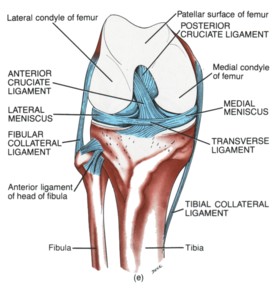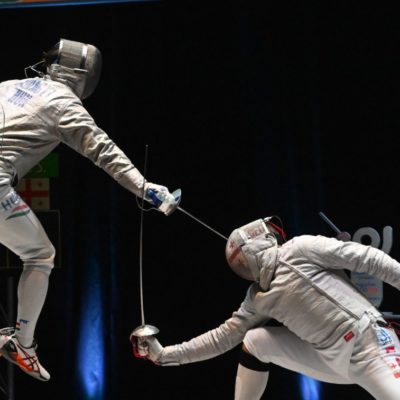ACL (Anterior Cruciate Ligament) injuries occur in fencing, but they can be prevented with the right approach to training. This article touches on prevention, treatment, and rehabilition of ACL injuries.
ACL Injury – Causes, Prevention and Treatment
ACL injury, or Anterior Cruciate Ligament injury, is another common problem that affects the knee joint. The ACL is damaged in about 70% of all serious knee injuries, which makes it the most common injury affecting the knee joint.
Anatomy of the Knee The anterior cruciate ligament is located within the capsule of the knee and connects the femur (thigh bone) to the tibia (shin bone).
The anterior cruciate ligament is located within the capsule of the knee and connects the femur (thigh bone) to the tibia (shin bone).
The picture on the right is a front-on view of the bones, tendons and ligaments that make up the right knee. In the middle of the picture there is a ligament called the "Anterior Cruciate Ligament." It is this ligament, most commonly referred to as the ACL, which is damaged in an ACL injury.
The ACL is responsible for restraining excessive forward movement of the tibia and limiting rotational movement at the knee joint.
How is the ACL Injured?
As with any sprain, an ACL injury is the result of excessive stretching or tearing of the ligament. The severity of the injury can range from a slight stretching to a complete rupture. An ACL injury most commonly results from:
- A sudden stop or change of direction.
- A twisting motion at the knee joint.
- A blow or sudden impact to the front of the knee.
Athlete’s involved in sports that require a lot of running and change of direction and speed; (especially contact sports) are most susceptible to ACL injury. Sports that involve the highest risk are football, soccer, basketball, skiing, hockey and gymnastics.
What are the Signs & Symptoms of an ACL Injury?
The severity of the symptoms tends to correlate with the severity of the injury. In other words, the worse the injury, the worse the symptoms. The most common symptom of an ACL injury is pain and swelling at the knee joint.
Treatment for ACL Injury
A minor ACL injury is just like any other soft tissue injury and should be treated accordingly. This involves the application of R.I.C.E.R. (R) rest, (I) ice, (C) compression, (E) elevation and obtaining a (R) referral for appropriate medical treatment. The following two points are of most importance.
- Rest & Immobilization
Once a MCL injury is diagnosed it is important that the affected area be rested immediately. Any further movement or stress will only aggravate the condition and prolong recovery. It is also important to keep the injured area as still as possible. - Ice
By far the most important part. The application of ice will have the greatest effect on reducing bleeding, swelling and pain. Apply ice as soon as possible after the injury has occurred or been diagnosed.
How do you apply ice? Crushed ice in a plastic bag is usually best. However, blocks of ice, commercial cold packs and bags of frozen peas will all do fine. Even cold water from a tap is better than nothing at all.
When using ice, be careful not to apply it directly to the skin. This can cause "ice burns" and further skin damage. Wrapping the ice in a damp towel generally provides the best protection for the skin.
How long, how often? This is the point where few people agree. Let me give you some figures to use, as a rough guide, and then I will give you some advice from personal experience. The most common recommendation is to apply ice for 20 minutes every 2 hours for the first 48 to 72 hours.
These figures are a good starting point, but remember they are only a guide. You must take into account that some people are more sensitive to cold than others are. Also, be aware that children and elderly people have a lower tolerance to ice and cold. Finally, people with circulatory problems are also more sensitive to ice. Remember to keep these things in mind when treating yourself or someone else with ice.
Personally, I recommend that people use their own judgement when applying ice to them self. For some people, 20 minutes is too much. For others, especially well conditioned athletes, they can leave ice on for up to an hour at a time. The individual should make the decision as to how long the ice should stay on.
My personal recommendation is that people should apply ice for as long as it is comfortable. Obviously, there will be a slight discomfort from the cold, but as soon as pain or excessive discomfort is experienced, it is time to remove the ice. It is much better to apply ice for 3 to 5 minutes a couple of time an hour, than not at all.
During the first 24 to 72 hours after an injury, be sure to avoid any form of heat at the injury site. This includes heat lamps, heat creams, spas, Jacuzzi’s and saunas. Avoid all movement and massage of the injured area. Also, avoid excessive alcohol. All these things will increase the bleeding, swelling and pain of your injury. Avoid them at all costs.
ACL Surgery
For major ACL injuries, including a complete tear of the ligament, surgery will be necessary. The specific procedures for each surgery varies according to the degree of damage done, the age of the patient, the activity level of the patient and if there are any other injuries to the knee joint.
There are a number of tests your doctor or physical therapist can perform to help determine the extent of the damage of the ACL. Depending on certain factors your doctor may also choose to perform an x-ray and MRI, but these are not always necessary.
As it is not possible to repair the ACL by simply reconnecting the torn ends, in most cases, surgery will involve using a segment of another healthy ligament to replace the damaged ACL.
After surgery, expect to be on crutches for one to three weeks. Full recovery, using a comprehensive rehabilitation program will generally take about three to four months and athletes involved in high demand sports can be back on the field in about six to eight months.
For more detailed information on ACL tears and ACL surgery, visit the following sites.
- http://www.yourmedicalsource.com/library/acltears/ACL_whatis.html
- http://www.sportsci.org/encyc/aclinj/aclinj.html
- http://orthopedics.about.com/cs/aclrepain/a/acl.htm
ACL Injury Prevention
Although it is important to be able to treat ACL injury, prevention should be your first priority. So what are some of the things you can do to help prevent an ACL injury?
- Warm Up properly
A good warm up is essential in getting the body ready for any activity. A well-structured warm up will prepare your heart, lungs, muscles, joints and your mind for strenuous activity. If you would like to know more about the warm up, visit http://www.thestretchinghandbook.com/archives/warm-up.htm. - Avoid activities that cause pain
This is self-explanatory, but try to be aware of activities that cause pain or discomfort, and either avoid them or modify them. - Rest and Recovery
Rest is very important in helping the soft tissues of the body recover from strenuous activity. Be sure to allow adequate recovery time between workouts or training sessions. - Balancing Exercises
Any activity that challenges your ability to balance, and keep your balance, will help what is called, proprioception: – your body’s ability to know where its limbs are at any given time. - Stretch and Strengthen
To prevent ACL injury, it is important that the muscles around the knee be in top condition. Be sure to work on the strength and flexibility of all the muscle groups in the leg. - Footwear
Be aware of the importance of good footwear. A good pair of shoes will help to keep your knees stable, provide adequate cushioning, and support your knees and lower leg during the running or walking motion. - Strapping
Strapping, or taping can provide an added level of support and stability to weak or injured knees.
———————————————————–
Article by Brad Walker. Brad is a leading stretching and
sports injury consultant with over 15 years experience
in the health and fitness industry. For more articles on
stretching, flexibility and sports injury, subscribe to
The Stretching & Sports Injury Newsletter by visiting
http://www.thestretchinghandbook.com/newsletter.htm.
———————————————————–





